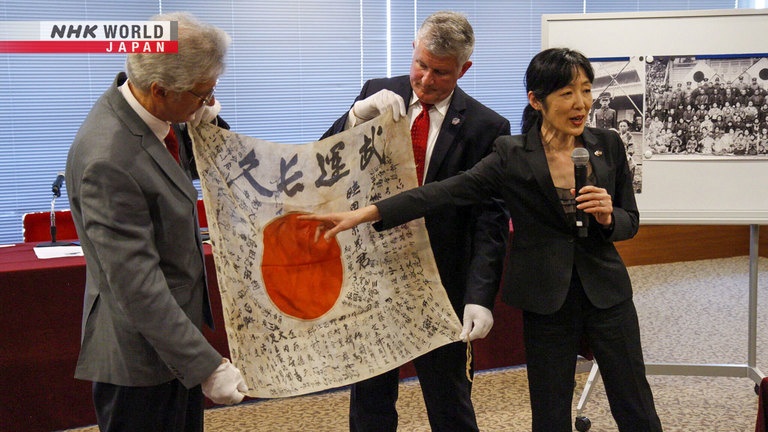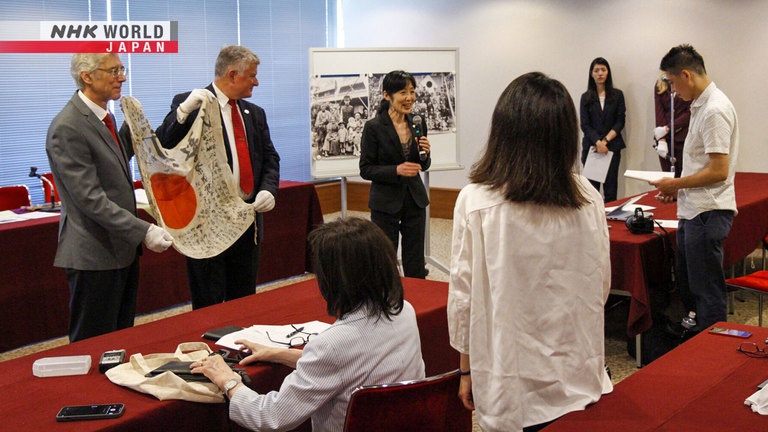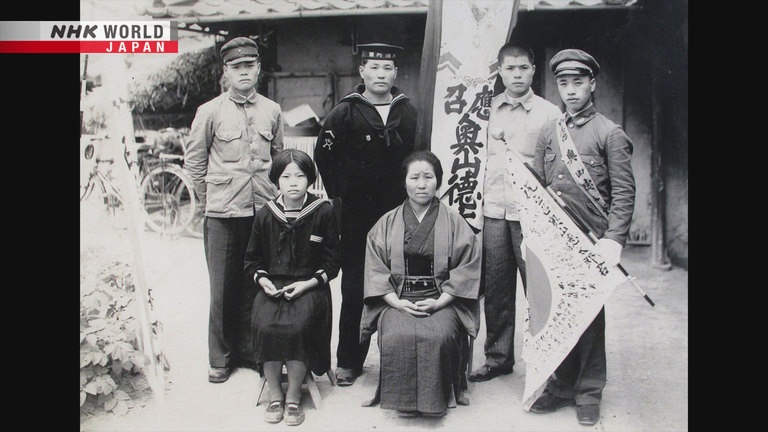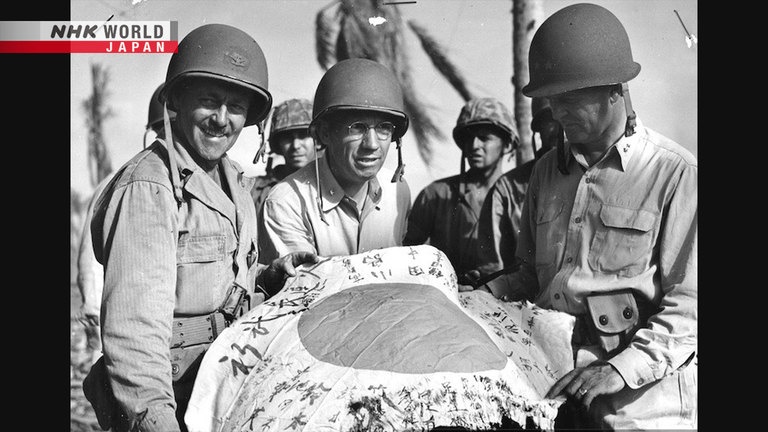Returning Flags To Heal Wounds of War: Keiko Ziak / Co-Founder, OBON SOCIETY
Keiko Ziak is a co-founder of OBON SOCIETY whose mission is to return flags which belonged to Japanese soldiers who died in World War II. She tells us why the wounds of war are finally being healed.

Keiko shows a flag of a missing Japanese soldier which was returned from the US this July

Keiko talks at a press conference

Japanese soldier with a Yosegaki Hinomaru or "Good Luck Flag" (Photo courtesy of OBON SOCIETY)

Flag taken by US soldiers (Photo courtesy of OBON SOCIETY)
Transcript
Direct Talk
Our guest today is Keiko Ziak,
the co-founder of OBON SOCIETY,
a non-profit organization
located in the United States.
Over the last 14 years,
she has worked with her husband Rex,
to return hundreds of Yosegaki Hinomaru,
otherwise known as Good Luck flags,
to families in Japan.
These flags were once a popular item
among American soldiers,
to take home from
the battlefields of World War 2.
Now these flags are being found in attics
and museums all over America.
While for Japanese bereaved families,
whose relatives went missing in action
during the war,
they represent the spirit
of the missing soldier.
We sat down with Keiko
to ask how returning these lost flags,
is helping to heal the wounds of war.
These flags are important
more than anything else.
They were worn by our fathers
and grandfathers.
When their spirits are returned
we finally feel a sense of closure.
I will take this flag back
to my deceased mother
to tell her and our ancestors
that he has finally returned.
I hope the bereaved families
will find closure and that
peace, friendship, reconciliation
will spread all over the world.
Returning Flags to Heal the Wounds of War
Tokyo
July 29, 2023
This July, OBON SOCIETY
organized a ceremony,
which brought together
a Japanese bereaved family
and a delegation from
an American maritime museum,
so that a Yosegaki Hinomaru could return
to its home after almost 80 years.
This is one of many return ceremonies
the group has carried out
over the last decade.
If you didn't know how important
these flags are to the bereaved families,
you wouldn't be compelled to return them.
But when you learn the true meaning,
You realize that fallen Japanese soldiers
also had loving families.
These families never forget and
always think about these soldiers.
When you realize this, it doesn't matter
whether you are Japanese or American.
Loving your family is
the same around the world.
Yosegaki Hinomaru were covered with
well wishes from friends and family,
and given to Japanese soldiers
before they went off
to the front lines during World War 2.
These flags were carried in battle
for good luck.
But thousands of them were taken home by
American soldiers from those who had fallen.
Until the end... best wishes...
Keiko, originally from Japan
and now living in Oregon, US,
co-founded OBON SOCIETY,
with her husband Rex,
to return these flags
to the bereaved families in Japan
They give public talks around the country
to inform Americans
about the meaning of these flags.
As awareness grows through the media,
hundreds of people get in touch
about flags in their possession.
Many of them were left forgotten in the
attics of war veterans or found in museums.
It is estimated there are about
50 thousand flags in the US.
Whereas about 8 million Japanese soldiers
were called up in the last war.
OBON SOCIETY has returned
close to 600 flags to Japan.
When Keiko and her team receive a new flag,
they try to identify the original owner
by looking for clues
among the writing they are covered in.
Whether it is the soldier's name,
their local temple,
or the place they worked or studied.
Any detail can be crucial for
locating the bereaved family in Japan.
The moment the family receives
the flag, it is no longer a flag.
It's the soldier himself.
It means "welcome back."
Nothing comes back from the battlefield.
No remains nor belongings.
Your father is gone.
When you face that situation,
you wonder what happened.
How did his life end?
Why didn't he come back?
There is no end to these feelings.
There are millions of people
like this in Japan.
The flags were worn by our fathers
and grandfathers.
When their spirits are returned
you finally feel they're back.
You finally feel a sense of closure.
Keiko and Rex founded OBON SOCIETY
because Keiko experienced firsthand,
the miracle of a Yosegaki Hinomaru
coming home.
The flag belonging to Keiko's grandfather
who died in battle during WW 2,
ended up in the hands of a collector
in Toronto, Canada.
Before the collector died,
he asked his son to return the flag to Japan,
who managed to do so,
with the help of locals in Tokyo.
When Keiko's grandfather
went missing in action
he left behind his wife and young children,
one of whom is Keiko's mother.
My grandfather's remains and
belongings never returned.
I'm the granddaughter of a
missing soldier.
My mother had no memory of her father
because she was never raised by him.
She struggled through the postwar years
and then brought us to the world.
My grandmother never talked about
the war but she always said,
"I was born under these stars
and I have no choice."
She never blamed the war.
She said this was her fate.
So, even though my mother wondered
why she had no father,
she knew this was a question that
she shouldn't ask.
These conversations were forbidden.
My grandfather's flag returned
in the Summer of 2007.
She was so happy.
My mother called me and said, "Keiko,
the Yosegaki Hinomaru has returned."
I thought, what is that?
I had never heard of it
or seen it before.
She told me the flag with my
grandfather's name on it had come home.
I didn't understand the significance
at first.
But when I saw it,
it was beautiful.
There was no mud or blood on it.
It was clean, white with
crisp folds.
The names of my grandfather and
his neighbors were written on it.
I remember how my mother reacted.
She said, "Grandpa finally decided to
come to see us after all these years."
I was surprised to hear that.
When I saw my mother's reaction,
I realized how ignorant I was
about the war.
I didn't understand what she meant.
It was...
this experience with my mother...
that transformed me to who I am today.
Keiko's husband and co-founder
of OBON SOCIETY, Rex Ziak
has a background as a historian,
and a photographer.
His skills as a professional speaker
have helped spread awareness
about their mission all over America.
After Keiko shared the story
of her grandfather's flag,
he realized the significance of these flags
for people in Japan,
and knew that they had to do
something about it.
So, I hear this story, and I'm thinking,
what was it?
A Japanese flag with writing...
I've never heard of such a thing.
And I'm thinking about it
but I told her there:
we should bring more miracles
to people like this. Like your family.
And I didn't even know
what I was talking about,
but just the idea of this,
because it was so powerful for her,
the idea that this missing grandfather,
now she had a grandfather.
His spirit came back.
They spoke to the flag,
like it was him.
In April of 2023,
through a series of fortunate circumstances,
OBON SOCIETY was informed about
the discovery of a flag,
that belonged to a Japanese soldier
named Mutsuda Shigeyoshi.
Mutsuda was born in Gifu Prefecture, Japan,
and called up to fight in 1943.
He died in action
barely a year later in Saipan.
He left behind a wife, Masae,
and three children,
Toshihiro, Yasunori and Misako.
Masae became the sole breadwinner
for the family
and passed away five years ago, aged 102.
Throughout her life,
she kept his memory alive
and lamented the fact that
no part of her husband ever came home.
When the flag was returned
to the bereaved family this July,
the eldest son, Toshihiro, was deeply touched
because of what this moment
would have meant to his mother.
I think my mother is the happiest
about the flag coming home.
Seeing it today made me
feel strongly, once more
that such a war should never
happen again.
I don't want anybody to grieve
like this any longer.
I will take this flag back
to my deceased mother
to tell her and our ancestors
that he has finally returned.
The Flag was part of an exhibit
aboard the USS Lexington,
a former World War 2 aircraft carrier,
and now a museum located in Texas.
For 29 years the flag was misidentified
as belonging to a kamikaze pilot.
But a photograph of Mutsuda
wearing the flag, proved unequivocally,
that it was a Yosegaki Hinomaru
that belonged to him.
At the request of the Mutsuda family,
OBON SOCIETY reached out to the museum staff
and explained to them
the significance of the flag.
Upon finding out what the flag represents
they decided it would be right
to return it to the family.
When we learned all of this,
and that the family
would like to have the flag,
we knew immediately that
the flag did not belong to us.
We knew the right thing to do
would be to send the flag home
to be in Japan, and to the family.
It was a miracle.
Mutsuda Shigeyoshi waited for
80 long years
to be finally reunited with his
beloved wife.
His perseverance is incredible.
Through us, his spirit must have
reached the people at USS Lexington.
I wonder if this was a miracle or
something destined to happen?
After nearly 80 years, a flag lost in battle,
returns to its rightful home.
It's wonderful work but there are
many hardships on the way.
Even so, when I see the smiles of
the families,
all the stresses just disappear
and I am filled with joy.
With the return of this flag,
a family is finally reunited.
But there are still
thousands of Yosegaki Hinomaru
trying to make their way home.
With time it may one day be possible
for more families to experience
these feelings of closure and reconciliation.
We asked Keiko to write down a phrase
that represents her hopes and
aspirations for the future of OBON SOCIETY.
Peace, friendship, reconciliation
We hope that the return of
each Yosegaki Hinomaru,
will bring closure to
the bereaved families.
And also bring to
everybody involved
peace, friendship and reconciliation
whose message will reach
all over the world.